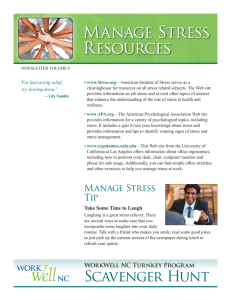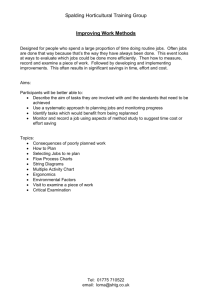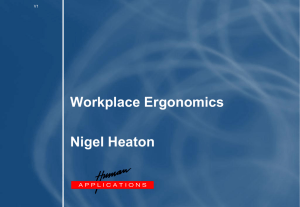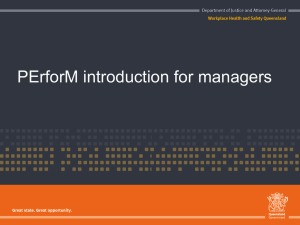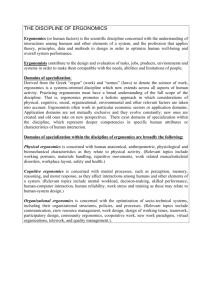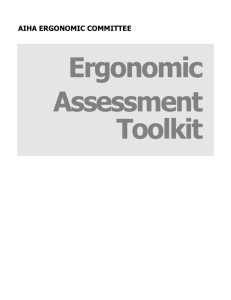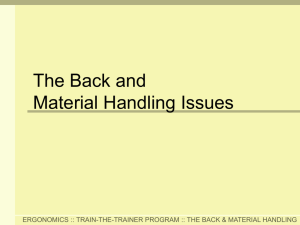Ergonomics
advertisement
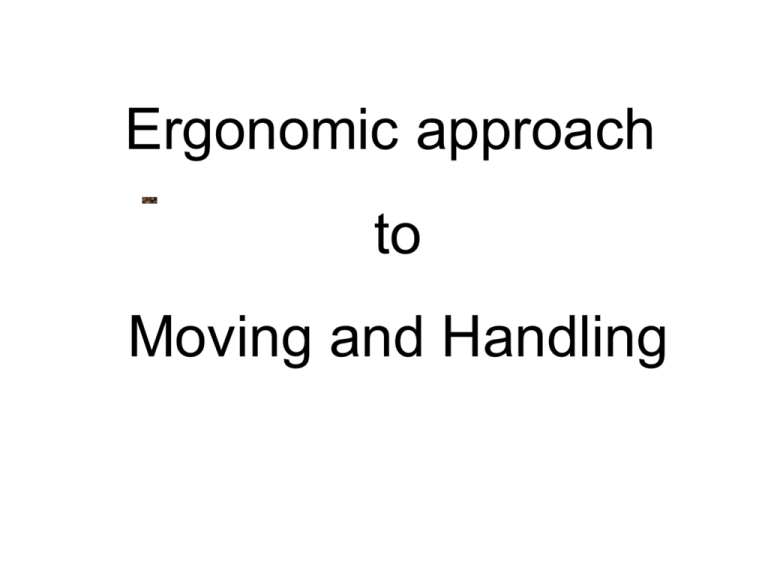
Ergonomic approach to Moving and Handling What is Ergonomics? Ergonomics’ is derived from two Greek words • Ergon meaning work • Nomos meaning principles or laws Ergonomics = The Science of Work Ergonomics is not a new science, although the term has become more common lately. The phrase was first coined in 1857. Definition Ergonomics is essentially fitting the workplace to the worker and with the design of safe systems of work. . The better the fit the higher the level of safety and worker efficiency.” Grandjean 1990 Work station assessment What are the consequences of poor Ergonomics? Occupational Disorders (some first documented in the 17th century): • • • • • • • house-maid’s knee washer woman’s thumb writer’s cramp clergyman’s knee weaver’s bottom dustman’s shoulder tailor’s ankle Postural Analysis • Spatial arrangement of individual body sections • Assessment of postural tolerability (Columbini and Occhipinti, 1985) Ovako working Posture Analysis System Reducing Musculoskeletal Injuries in Patient Handling Successful strategies have involved changes in: • Work organisation • Working practices • Design of the environment (Hignett 2003) Physiotherapy Injuries (2005) • 67.5% of physiotherapists report work-related musculoskeletal disorders of these: • 48% affect the lower back • 40% report hand, thumb & wrist problems • 33% report neck problems Costs to the NHS • Back injuries among staff cost £400 m a year • 80,000 nurses injure their backs at work • 3,600 healthcare workers retire early due to injuries BackCare 2011 Cost of Back Pain • NHS spends more than £1billion per year on back related costs • £565m spent in private sector on back pain treatments • Back pain & musculoskeletal disorders cost UK employers between £590 & £624 per year (HSE) • Total cost of back pain = 1-2% of GNP www.Backcare.org Predictors of Back Pain in Health Care Professionals • Transferring patients between bed and chair • Static postures in supporting/treating patients • Assisting patients to walk / fall risk What would you do? • Mrs Groves , (who weighs 85 kgs) needs help to change position in bed • Ms. Close (who has a history of falls) needs help to walk to the toilet. • Mrs Green (who has had a stroke) has slipped down in her chair and is in danger of sliding onto the floor Legal Aspects of Moving and Handling There is legislation that encompasses manual handling at work: • Ensure compliance with the relevant law on moving and handling • Understand responsibilities of the employer in relation to moving and handling of patients • Know responsibilities of health care professionals in relation to moving and handling of patients and follow safe practice Where does legislation come from? • Acts of Parliament • EC Directives and Legislation • Common Law (Case Law, Judicial Decisions, Leading Law from the Law lords) English Legal System Criminal Law Civil Law -Deterrent & Punishment -State v Offender -Statues, Acts , Regs -Compensation -2 parties in dispute -Some Acts, Regs -Prosecuted -Sued (can be insured against) -Higher burden of proof -Lower burden of proof Beyond reasonable doubt - Balance of probablities Innocent until proven guilty Common Law of Negligence • Duty of Care was owed • The Dutyof Care was breached due to a careless action or omission • The breach directly caused harm • It was reasonably foreseeable (Bolam Test) Key Legislation Health and Safety at Work Act (HASAW) 1974 EC Directives Management of Health and Safety at Work Regulations (MHSAW) 1992 Workplace (Health,Safety & Welfare) Regulations, 1992 Provision and Use of Equipment Regulations (PUWER) 1998 Display Screen Equipment Regulations, 1992 Personal Protective Equipment at Work, 1992 Manual Handling Operations Regulations (revised 1998) (MHOR) 1992 Lifting Operation and Lifting Equipment Operations (LOLER) 1998 Other Relevant Legislation • Reporting of Incidents, dangerous diseases or Occurrences Regulations 1995 • Human Rights Act 1998 • Disability Discrimination Act 1995 • Mental Capacity 2005 Implementation of Legislation The Health and Safety Commission (HSC) oversees the Heath and Safety Executive (HSE) which holds responsibility for the enforcement of regulations at a practical workplace level. – Advisory committees. – Guidelines – Codes of Practice. Government HSC HSE A number of professional bodies have produced documents in response to the legislation: – Royal College of Nursing – Chartered Society of Physiotherapists – College of Occupational Therapists – Society of Radiographers etc. We must be aware of the following issues in relation to moving and handling in the caring environment: – There is an inherent risk of injury for people who are involved in the regular handling of loads. – As a physiotherapist, your most common ‘load’ will probably be people. – For numerous obvious reasons, people are amongst the most difficult and demanding of all loads. – As a carer you are more at risk from injury caused by manual handling than people in any other occupation. MHOR ~ Duties of employers… Avoid hazardous manual handling so far as is reasonably practicable Make suitable and sufficient assessment of any hazardous manual handling operations that cannot be avoided Reduce the risk of injury from those operations as far as is reasonably practicable Duties of employees… Take reasonable care for their own health and safety and that of others who may be affected by their activities Co-operate with their employers to enable them to comply with their health and safety duties Make use of appropriate equipment provided for them Follow appropriate systems of work laid down Students on Clinical Placements Health and Safety at Work Act & Manual Handling Regulations apply to ALL workers including students on work experience i.e. students on clinical placements The range of what we think and do is limited by what we fail to notice. And because we fail to notice there is little we can do to change until we notice how failing to notice shapes our thoughts and deeds (R.D Laing - cited by Daniel Goleman in Vital Lies, Simple Truths) Anatomy and Biomechanics Typical Lumbar Vertebra Pressure measured in L3 / L4 disc during different postures Some Predisposing Factors to Back Pain • • • • • • Genetic inheritance Unaccustomed work Injury Fatigue Ageing Smoking Handling Definitions • Manual Handling involves transporting or supporting a load lifting/lowering/pushing/pulling/carrying • Treatment Handling = manual handling in a treatment programme i.e. any treatment where force is applied through any part of the therapist’s body to or from any part of the patient. TASKS • List 3 tasks where you might be vulnerable to back ache • Identify the underpinning factors • What PRINCIPLES could you apply to avoid back ache Common Causes of Back Pain • Loading • Twisting • Repetition • Sudden jerky movements • Sustained poor posture Guide to the Handling of People • Assess and identify risks • Decide on safe system of work – risk is unlikely to be ZERO • Prioritise actions - need for assistance, further advice, equipment • Use of 'personal handling profiles' • Use recognised, accepted manoeuvres Assessment of risk Task Individual Capability Load Environment Equipment Risk Assessment • Generic - for potentially hazardous situations • Specific - for patients whose treatment programme may involve potentially hazardous manual handling ASSESSMENT OF RISK… THE TASK… Will it involve… Holding or manipulating the load at a distance from the trunk? Unsatisfactory body movement or posture, especially: • twisting? • stooping? • reaching upwards? ASSESSMENT OF RISK…Will it involve? Excessive movement of the load, especially: – excessive raising or lowering distance? – excessive carrying distance? – excessive pulling or pushing? Risk of sudden movement of the load? Frequent or prolonged physical effort? Insufficient rest or recovery periods? A rate of work imposed by a process? INDIVIDUAL CAPABILITY …Does the job • Require unusual strength, height, etc? • Create a hazard for those who are pregnant or have health problems? • Have you… – The capacity to move the load? – Any disabilities that could affect safety? – The skills required for this task? • Are you wearing any hazardous clothing, jewellery or shoes that could get caught or cause injury? Appropriate clothing and footwear The Load – Is it… • • • • Heavy Bulky or unwieldy Difficult to grasp Unstable or with contents that are likely to shift? • Sharp, hot or otherwise potentially damaging Maximum Safe Loads for Lifting and Lowering Under the Health and Safety Regulations the maximum safe loads for an individual for lifting and lowering are: For two persons working together the maximum load is equal to 2/3 the combined safe load. The Working Environment …Are there? • • • • • Space constraints or obstacles? Uneven, slippery or unstable floors? Variations in level of floors or work surfaces? Extremes of temperature or humidity? Conditions causing ventilation problems or gusts of wind? • Poor lighting conditions? • Distractions, e.g.: noises? • Pieces of equipment available that would help? Equipment Hoist Moving and Handling Aids • • • • • • Profiling beds Slide sheet Sliding boards Turntables Hoists Standing aid hoists • Riser/recliner chairs • Bath seat or boards • Bath lift or hoist THE PATIENT or CLIENT… • Think about the person… – What are their abilities? – What is their size, weight and shape? – Consider their age, gender and cultural and religious background – What is their medical condition? Do they have any painful areas, discomfort, fractures or wounds, skin conditions etc? – Any special problems? THE PATIENT or CLIENT… • What clothing are they wearing? Is this a hazard? • Do they have any attachments? • Ensure privacy if they are in a state of undress • Can the patient/client understand you? • What are their attitudes/feelings about being moved or handled? • What are their previous experiences of being assisted? Possible reasons for injury to patients during moving and handling 1.Friction 2.Joint damage 3.Resistance from the client 4.Falls. What About Emergencies? • Emergency situations where people are being cared for, are foreseeable and Risk Assessments should be carried out for these • A hospital/institution should expect that people (patients, visitors & staff) may collapse in any location. Falling and recovery from the floor • Don’t catch ~ let person fall, save head only if safe to do so. • Patient must initially be assessed by a Registered Practitioner. If no injury, encourage patient up using chair for support. Teamwork One person should give the commands All should understand manoeuvre (including the patient). EFFICIENCY of MOVEMENT • Keep a stable stance & avoid twisting • Keep as close as possible to the weight – keep hands within your base • Put effort into moving Centre of Gravity of load or person • Use head movement to initiate movement Efficiency of Movement • Keep vertical effort to a minimum • Use major muscle groups for effort • Use smooth movements / avoid excessive muscular tension • Reduce friction for horizontal movements Standards of Physiotherapy Practice • Patient partnership • Clear Communication • Comprehensive risk assessment • Safe working practice – evidence based • Accurate Documentation • CPD References Grandjean (1990) Fitting the Task to the Human The Health and Safety Commission (1997) Statistics RCN (2009) The Guide to The Handling of People 6th Edition CSP (2008) CSP Manual Handling Guidance
